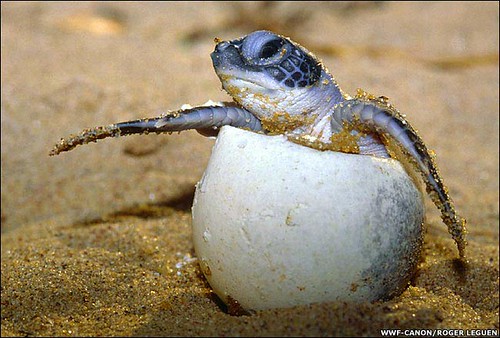As Columbus sailed the ocean blue, the ride was a little bumpy!
Turtles have much potential to be alive and thriving creatures. As a hatchling, you have over one hundred brothers and sisters. It is your job, as a little sea turtle, to make it to the ocean. When you have made it, you will make a three day journey without food and without rest. Getting here soon as possible is your mission. When you arrive, you will continue on with your life. You can live up to 80 years, but can only mate between the ages 0f 20 and 30. When you need to make your nest, you return to the place you were born, and lay them. You return to the ocean and continue to live your life while 55 days later, your eggs will hatch, and your babies make the same journey you have...
...many will not live in this day.
Turtles today are now a highly endangered species. 1 in 10,000 turtles live to adulthood.
Every year, from March 1st to October 31st, turtles begin to nest onto the beach. As we all know, beaches have became the "hot spots" for tourists and for people looking for a tropical paradise to live in for the rest of their life. The beaches have become heavily populated with great towers lined up for miles, and each year the lights from these towers have caused disorientation in turtles - when turtles go towards the city lights instead of the ocean. A hatchling in a busy street can be fatal.
All of the bright lights from the buildings cause this, rather they are inside the building, or out. When hatchlings make a journey to the city instead of the ocean, they are likely to be killed. Turtles can be ran over by automobiles, starve to death, eaten by predator birds, or caught inside drains on the side of city streets if misguided.
The buildings and streets are not the only threat to our beloved sea critters. thousands of sea turtles are killed by fishing from fishing line, nets and rope. Boats in near shore waters can hit sea turtles - injuring them or killing them.
 The threats do not end there. While fishing and boats can injure or kill the adult and juvenile turtles, pollution in the habitat of sea turtles injure, sicken and kill the adult, juvenile and hatchlings.
The threats do not end there. While fishing and boats can injure or kill the adult and juvenile turtles, pollution in the habitat of sea turtles injure, sicken and kill the adult, juvenile and hatchlings.The habitat of the water is not the only thing diminishing the population of sea turtles. Beach life can harm the hatchlings, or prevent the mother turtle from not nesting at all!
How do you know if you are harming the sea turtles? Here are a few tips:
- -When you see trash, pick it up! Turtles think that the trash is their food, when in reality, it is their doom.
- -Take all of your beach equipment with you as you leave! If your chair is in front of a hatchling as it tries to make its way to the ocean, it could become stuck underneath it and get injured, or worse.
- -Don't help pollute anything! If you wouldn't want a stranger ruining your home, don't do it to others.
- -Use red or amber colored bulbs in the nesting season! The nesting season is from March 1st to October 31st. While it is light, it is dim light that cannot disorient turtles as much as white light will.
- -If you must check upon the nests, use only low watt red lights! White light could cause them to become disoriented.
- -No flash photography! It will also disorient the hatchlings.
- -If you see a mother turtle, be calm, be quiet, and be far! Females will not nest if you are bothering them. No nest = no hatchlings = less sea turtles
In the state of Florida, touching a nesting female is considered animal abuse since sea turtles are endangered. If you see a female turtle, try not to spook her.
Credit goes to the S.T.O.P. organization. All of the information I have received, I have received from them. For more information on the rescue of sea turtles, go to SeaTurtleOP.org
 |
| The sea turtles thank you! |

